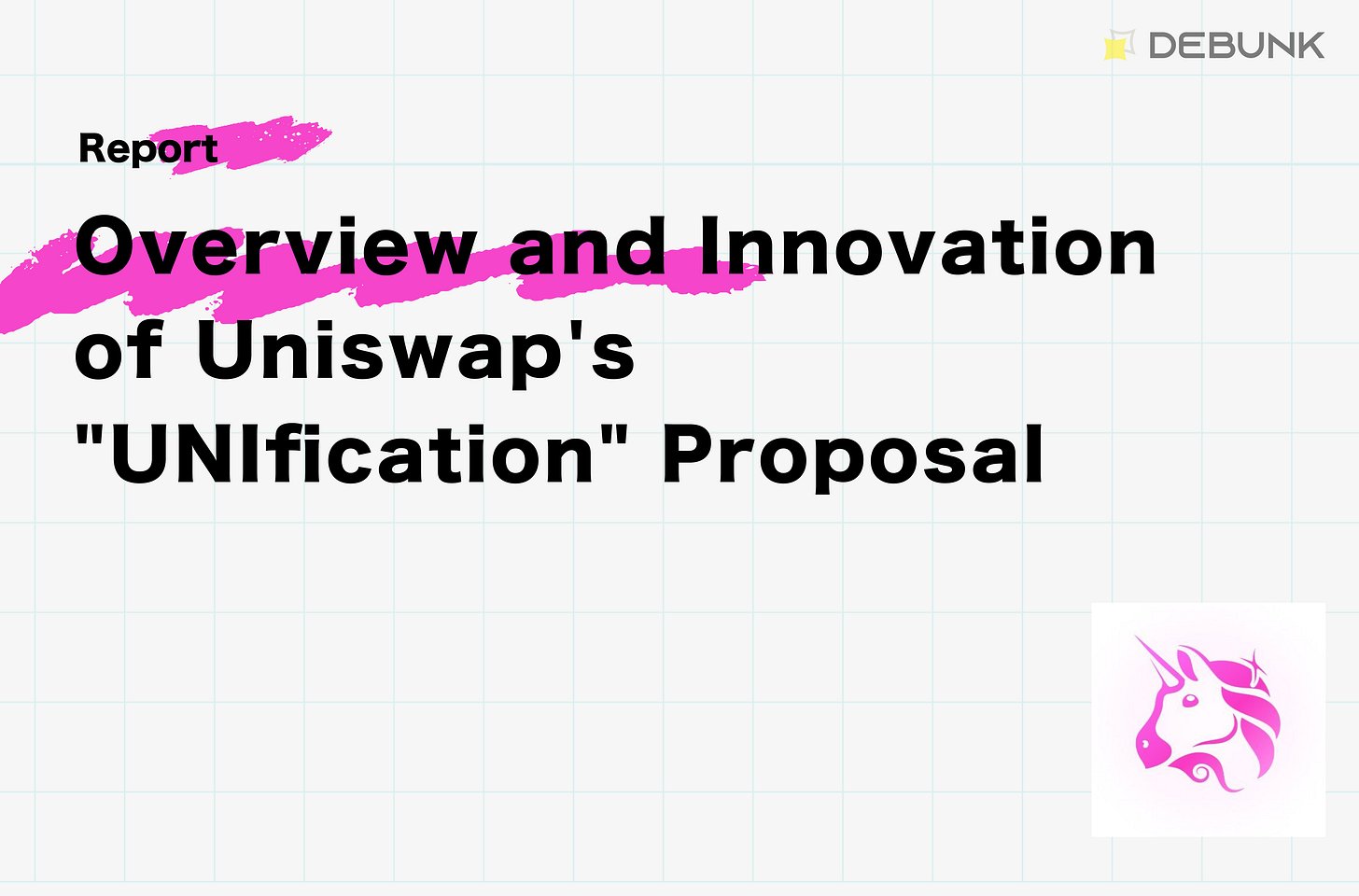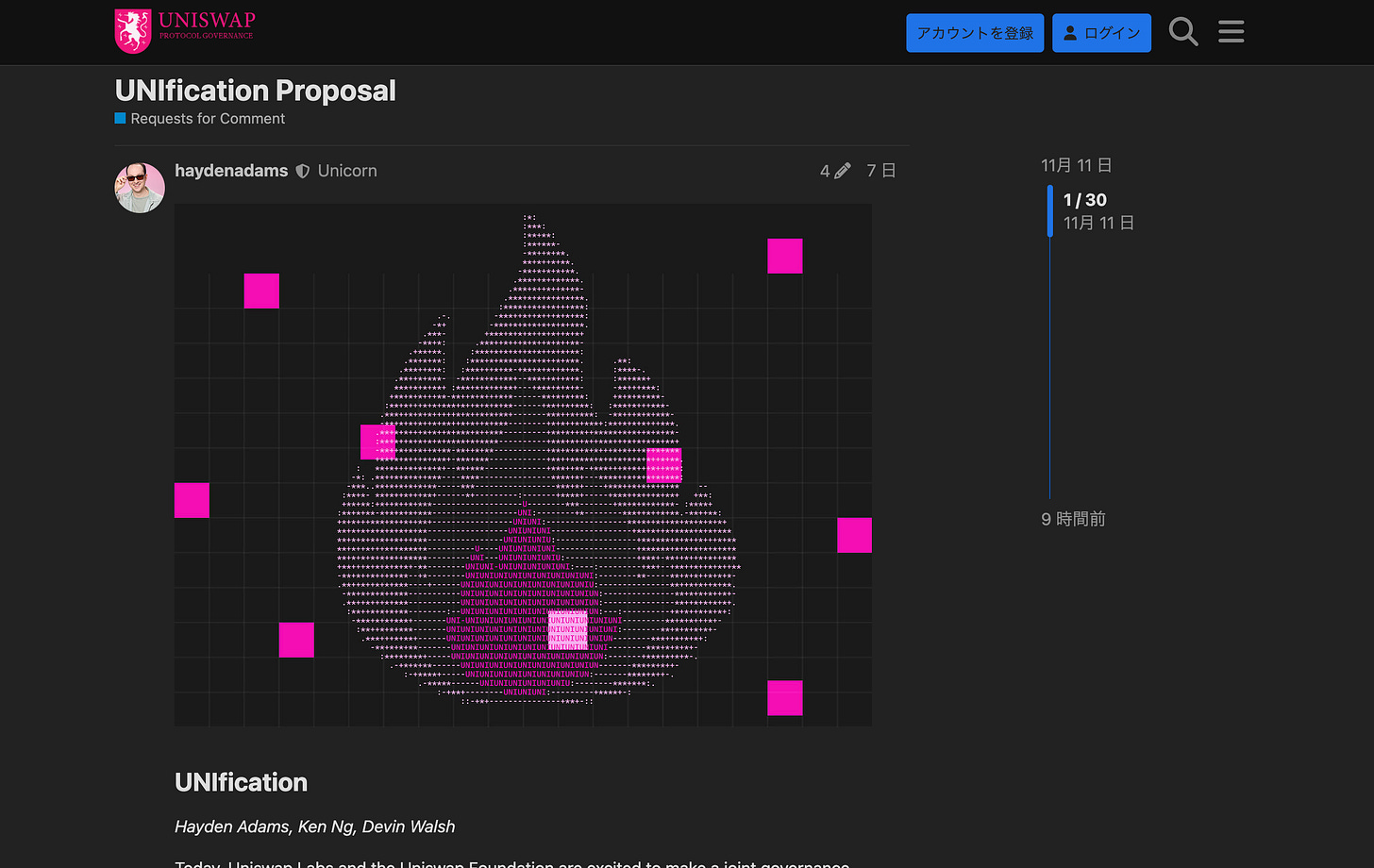Overview and Innovation of Uniswap's "UNIfication" Proposal
Will it become one of the final forms of the protocol?
Good morning.
I’m Mitsui, a web3 researcher.
Today, I’ll explain the “UNIfication Proposal” recently announced by Uniswap. I find this proposal incredibly interesting and innovative, so please watch until the end.
Background and Purpose of the Proposal
Details of the Proposal
Supporting Arguments and Concerns Regarding the Proposal
Token Burn Strategy for Other Protocols
Will the Uniswap model become one of the final forms of the protocol?
TL;DR
The “UNIfication” plan announced on November 10, 2025, will enable the Fee Switch and UNI burn to return value to users while unifying the governance structure through the integration of Labs and the Foundation.
v2/v3 protocol fees fully burned as UNI via TokenJar/Firepit, Unichain fees similarly burned, MEV internalized via PFDA, v4 aggregator hook adds fee surcharge to external liquidity, 100 million UNI special burn from treasury, Unisocks LP migration & LP burn.
The RFC → Snapshot → on-chain voting process is expected to take approximately 22 days. If all goes smoothly, execution is projected to begin in early December.
Background and Purpose of the Proposal
The “UNIfication Proposal” is a proposal jointly released by Uniswap Labs (the developer) and the Uniswap Foundation (the foundation) on November 10, 2025. It aims to further advance Uniswap through the activation of protocol fees, token value redistribution via UNI burns, and the integration of key development teams.
Uniswap has become a central player in DeFi, with cumulative trading volume reaching approximately $4 trillion. However, the UNI token has lacked a direct link to protocol revenue, making token value enhancement a challenge. Furthermore, over the past several years, development has proceeded while facing legal risks within the SEC’s regulatory environment (characterized by a strict stance under Chairman Gensler).
Amidst this, in 2024, a proposal to establish “DUNI”—an entity legally protecting Uniswap governance under Wyoming’s new law (Distributed Unincorporated Association: DUNA Act)—was passed, reducing the legal uncertainty surrounding governance. Furthermore, from 2023 to 2025, regulatory clarity in the U.S. advanced, creating an environment where Uniswap Labs could become more proactive in governance involvement.
Following these preparations, the Uniswap community is now poised to enter a new phase.
Through this “UNIfication proposal,” we aim to establish a long-term model for the Uniswap ecosystem and transition to a mechanism where protocol usage contributes to increasing UNI’s value (deflationary effect).
Details of the Proposal
The proposal consists of the following eight points.
Enable Uniswap protocol fees and burn UNI using those fees.
Send Unichain sequencer fees to this same UNI burn mechanism
Build Protocol Fee Discount Auctions (PFDA) to increase LP revenue and enable the protocol to internalize MEV
Launch the aggregator hook to transform Uniswap v4 into an on-chain aggregator that collects fees using external liquidity.
Burn 100 million UNI from the treasury. This represents the approximate amount of UNI that would have been burned had fees been charged from the outset.
Focus Labs will drive the development and growth of the protocol through measures such as eliminating interface, wallet, and API fees, as well as contractual commitments to pursue only initiatives aligned with DUNI’s interests.
With the shared goal of protocol success, growth and development will be funded by finance while transitioning the ecosystem team from the foundation to the lab.
Migrate Unisocks liquidity owned by Governance from Uniswap v1 on the mainnet to v4 on Unichain, burn LP positions, and permanently lock the supply curve.
This can be broadly categorized into three main areas, so I’ll explain them accordingly.
1–5: Enable Uniswap protocol fees and burn UNI with those fees.
6–7: Integrate Foundation and Labs to unify the promotion structure
8: Other
◼️Enable Uniswap protocol fees and burn UNI with those fees.
The Uniswap protocol originally included a “fee switch” feature allowing the protocol to capture a portion of trading fees, but this mechanism could only be activated through governance votes by UNI holders.
Keep reading with a 7-day free trial
Subscribe to DEBUNK(web3 Research) to keep reading this post and get 7 days of free access to the full post archives.



